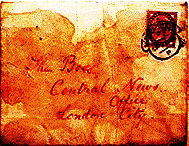I often wonder what sort of people wrote the letters that were sent in the name of “Jack the Ripper.”
From the few who were caught and convicted for having written some of the correspondence, such as Maria Coroner up in Bradford and Miriam Howells in Wales, it is evident that they were, mostly, inoffensive people, who probably didn’t think they were doing anything wrong in composing and sending their prank missives.
And the letters continued to be sent for many years after the autumn of terror of 1888, when the original “Dear Boss” “Jack the Ripper” letter had been sent and the name had first entered the public lexicon.

POISON PEN MYSTERY SOLVED
On Wednesday, the 9th of November, 1934, the Daily Mirror reported on the court appearance of a similar letter writer who had appeared in court at the Staffordshire Assizes:-
UNSUSPECTED FOR 25 YEARS
“When sentence of three years’ penal servitude was passed on Enoch Albert Knowles, at Staffordshire Assizes yesterday, it was revealed that he had been writing “poison pen” letters over a period of twenty-five years without raising suspicion.
Knowles, aged fifty-seven, of Park-street, Darlaston, pleaded guilty to sending menacing and offensive letters to women. He was charged with sending a letter to Mrs. Olive Polly Curtis, of Cannock, threatening to kill her or her husband; sending similar threats to Miss Winfred Louise Randle, of West Bromwich, and Mrs. Alice Rowley, of Heath Town, Wolverhampton; and sending offensive postcards through the post to Mrs. Curtis, Miss Randle and Mrs. Rowley.
AN OFFENSIVE LETTER READ OUT
Mr. A. S. Long, prosecuting, recalled the evidence given at Wednesbury Police Court, from which Knowles was committed, and read this extract from a letter sent to Mrs. Rowley:-
“I am going to tell you how I am going to murder you. When you are sitting in your house at night, I shall shoot a bullet through your window and shoot you – dead.”
Knowles appeared to have read of trials at Staffordshire Assizes, and though he was not concerned in them he sent threatening and scurrilous letters to the Judges and witnesses.
“JACK THE RIPPER”
He wrote to one woman who had given evidence and described himself as “Jack the Ripper, of Whitechapel.”
THE 1903 HORSE MAIMING CASE
“This has now let light on some things that had worried the authorities in this county for some years,” said Mr. Long. “In 1903 there was a case at the Quarter Sessions here of a man tried for maiming horses. This attracted a wide interest.”
The man was sentenced to seven years, said Mr. Long, but later was granted a pardon.
Following the trial all sorts of people who had been connected with the case got letters which indicated that in spite of the conviction the maimings would go on. Letters were received giving the times and places where maimings would take place.
Most of the letters purported to come from a person who signed himself “Darby, captain of the Wyrley gang.”
Knowles joined the Army in 1916. In 1919 he married, and until 1931 matters were quiet.
THIS CURIOUS DESIRE AGAIN
“But in 1931,” counsel went on, he apparently had this curious desire again.
“On one occasion he wrote a very cruel letter to a member of the Royal Family.”
HANDWRITING CLUES
The police and the Post Office authorities have been for years trying to find out who was writing these letters.
“One day a person in a sorting office found a postcard addressed to Droitwich signed ‘Enoch and Lizzie.’ It was in the same writing as some of the letters.
The police discovered that there was a man living in Darlaston named Enoch with a wife named Lizzie.
They also went through certain signatures that had been signed for council houses and found that Knowles’s tallied with the handwriting on the letters.
Superintendent J. H. Hall, of Wednesbury, handed in a list of letters either received by people or stopped in the post, and said Knowles had admitted the authorship of them.
NEVER SUSPECTED
The Judge: “There was no reason for suspecting him?”
“He has never been under suspicion at all.”
The Superintendent added that Knowles had made a statement that he had been writing letters for over twenty five years.
Defending counsel said that Knowles had never had the slightest intention of doing harm to anybody.
The letters appeared to indicate a weakened or disturbed mind.
THE EDALJI CASE
The man referred to by counsel as having been convicted in 1903 for horse maiming was George Edalji, a young Birmingham Solicitor and son of a clergyman of Great Wryley.
He was released in 1907 following an agitation by the late Sir Arthur Conan Doyle.”
